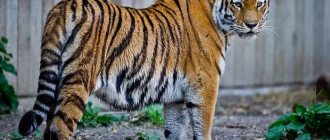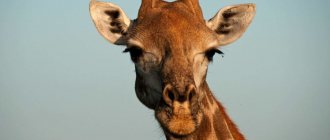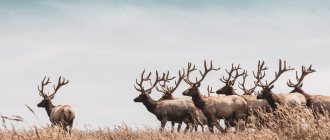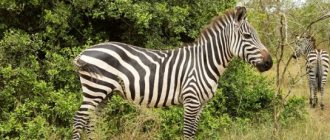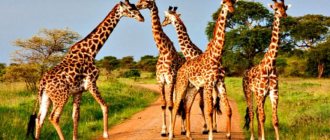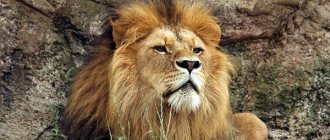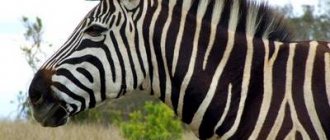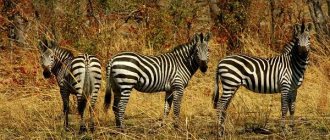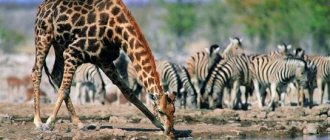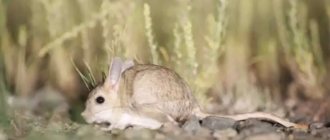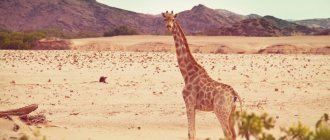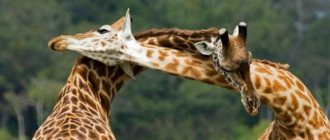Okapi, dwarf forest giraffe or Okapia Johnstoni (Johnston's okapi). This artiodactyl animal represents the genus okapi and belongs to the giraffe family. The discovery of the okapi shocked the world in the early 20th century because the animal looks like a wild cross between a zebra, a horse and a giraffe. Named in memory of the British traveler Harry Johnston.
| Latin name: | Okapia Johnstoni |
| Kingdom: | Animals |
| Type: | Chordata |
| Class: | Mammals |
| Squad: | Artiodactyls |
| Family: | Giraffidae |
| Infraclass | Placental |
| Genus: | Okapi |
| Body length: | Length - 2 meters, height - up to 170 cm |
| Weight: | 250 kg |
Description
Okapi peeks out from behind another okapi
- Advertisement -
To describe okapi briefly, this animal reminds many of a horse with a zebra color. However, okapi are far from equine representatives, because they belong to the order of artiodactyls. And as we know, horses are equid animals.
Appearance
The most interesting part of the okapi is its very distinctive coloring. The fur on the head area, sides and croup (gluteal muscles) is velvety and chocolate-colored with a strong red tint. The sides of the muzzle are white, the eyes are black, as is the nose and mouth. The ears are colored brown.
Okapi lowered his head, he must be sad
The front and hind legs are white with horizontal black lines extending down to the knees—this pattern is why people associate okapi with zebras.
— Advertising —
Adult okapi grow up to two meters in length and up to 170 cm in height. The length of the tail is 30-40 cm. The neck occupies two thirds of the body. The ears are tubular in shape with a strong point towards the end.
Males have small horns on their foreheads called ossicones. It is typical for these horns to change the tip once a year. Females do not have ossicones. By the way, female representatives of this species are taller than males. Also, both sexes have interdigital glands on the front and hind legs.
Okapi is hungry, but he is still wondering if he should eat this grass
A characteristic feature of the okapi is not only its coloring, but also its tongue. This bluish-colored organ grows up to 40 cm and with the help of it okapi can calmly wash itself. For example, he licks his eyes and ears. By the way, this is one of those body features that makes okapi look like giraffes.
The second feature is gait. Both giraffes and okapi move by simultaneously using their front and back legs on one side. Other ungulates use alternative legs for walking.
You can enjoy the beauty of this animal in the okapi photo below.
Range and habitats
Long Tongue Okapi
Okapi lives on the African continent. These animals have a rather meager distribution area. It includes only the territory of the state of the Democratic Republic of the Congo. The okapi's distribution is strictly limited to the high-altitude eastern forests, western swamps, northern savannahs of Sudan and open southern forests.
I wonder, then, in what natural zone do okapi live?
For their habitat, these artiodactyls choose dense tropical rain forests, mainly in the East and North of the country. These regions contain the Werunga, Maiko and Salonga national parks. Choose an altitude of approximately 500 m above sea level. There are cases when okapi climbs to a height of 1000 m. This happens in the eastern tropical forests.
№4
The giraffe is famous not only for its high neck, but also for its very long tongue, which helps it pluck leaves from trees. The okapi also has a long tongue. The giraffe's tongue is longer than that of the okapi. The length of a giraffe's tongue can reach 51 centimeters. The length of the okapi tongue varies between 36-45 cm. However, if you compare the length of the body in relation to the tongue, the okapi tongue looks more impressive.
What do okapi eat?
Okapi is about to have lunch
Since okapi are inhabitants of tropical forests, when they grow, they can get food from the lower tiers of trees. These animals use a long tongue to pluck fresh leaves from dairy trees and also to pluck nutritious fruits. Rarely, but there are still cases when okapi come out to nibble grass on open lawns.
Researchers estimate that the okapi diet includes about a hundred species of plants from 13 different families. However, these are occasional cases. 30 varieties of plants have been identified that are regularly included in the okapi diet - that is, they are considered favorites.
On this list, most of the plants listed are actually poisonous to humans, which puzzled researchers at the time.
Field observations by scientists have shown that okapi replenish their mineral and salt base by eating sulphurous, slightly brackish red clay, which is located along rivers. Also, analysis of the animal's feces showed that okapi feed on coal left over from trees.
Behavior
Okapi are solitary animals. The only exception is the mother-child pair. These animals live in hidden areas with a home range of several kilometers. However, males' home ranges are slightly larger than those of females. In the wild they are found at a density of no more than 0.6 animals per square meter.
Okapi up close
Even though okapis are not social animals, they tolerate each other patiently in the wild. There are times when okapi gather in small groups in order to feed. However, this does not last longer than a few days. All knowledge about okapi socialization has been collected thanks to representatives who live in captivity.
There is an assumption that okapi males mark their territory with urine. But what is known for sure: representatives of both sexes mark their territory by rubbing their necks on the bark of trees.
Okapi are somewhat aggressive animals. Observations have shown that dominant animals hold their necks straight and extend their heads high. A sign of submission is a head lowered to the ground. They can kick hard during a fight.
Playfulness and sociality are well demonstrated in both young okapi and adults. These animals communicate using voice. This includes communication between mother and baby okapi, warnings of impending disaster, and courtship by adults during the breeding season.
№5
They are herbivores, which means they only eat vegetation. Like giraffes, they pluck leaves from trees using their tongue.
In addition to vegetation, they also eat fruits, mushrooms, and berries. To replenish mineral reserves in their bodies, they consume clay, which they can find in river beds. They also eat charcoal.
For a normal adult life, it is necessary to consume about 20-27 kg of vegetation daily.
Reproduction
The breeding season occurs in May-June or November-December. Animals forget about their own preference to live alone and go in search of a partner. By the way, upon completion of copulation, the couple separates and the lives of okapi representatives return to their usual places.
Female and male okapi together
The new mother is completely responsible for further care of the offspring; the male does not take part in the life of the little okapi. The child grows in the womb for about 14 months (440 days) and just before the baby’s imminent birth, the mother goes into the depths of the forest.
Female okapi give birth to a baby weighing from 14 to 30 kg. Let us remind you that an adult okapi weighs on average 250 kg, so the weight of a baby is not a severe test for it. Children are quite independent from the first minutes after birth. So, after 20 minutes the cub finds the mother’s breast and drinks milk, and after half an hour begins to follow the mother.
A few days after giving birth, the mother builds a shelter for the child and goes in search of food. The mother is able to find the child by the sounds it makes. They are similar to the sounds of adult okapi: quiet mooing, soft whistling, or a slight cough.
Okapi calf with mother
Mother's milk is absorbed by the baby okapi's digestive tract down to the last gram. Milk forms the basis of a child’s diet for the next six months after birth. After this, the cub learns to eat the diet of an adult.
Okapi females have a highly developed maternal instinct. They protect the child even in the face of great danger. By the way, the fact that baby okapi’s droppings are odorless helps in many ways to avoid attacks from predators.
Okapi children live with their mother for a long time. The formation of a sexually mature system ends by the age of three. Interestingly, reproductive abilities open earlier. In females this occurs around the age of one year and 7 months, and in males at the age of two years.
Okapi life in captivity
The okapi animal was not recognized by scientists until 1900. However, when the world saw the first information about them, all major Western zoological parks began to try to replenish the collection of animals by obtaining okapi. The first captivity was carried out by the Antwerp Zoo. This happened in 1919, but the imported okapi lived in captivity for only 50 days and died.
Photo of a sad okapi close up
Subsequent attempts were also unsuccessful, until 1928. A female okapi was brought to the same zoological park, who lived for 15 years and died in 1943. Tele, as the okapi was called, died due to the fact that during the Second World War, little food was allocated to the animals and they died of starvation.
In 1954, the first okapi baby was born in captivity. The same place - Antwerp Zoo. He lived a short life and soon died. In 1956, the first okapi child was born, who was able to live for a long time, this happened on the territory of the Paris Zoo. Today, 160 okapi individuals are found in 18 zoological parks around the world in different countries.
Species status
Joyful okapi
In Uganda, okapi are a completely exterminated species. Since 1933, the family has been protected by Zairian and Congolese laws. It is listed in the World Red Book as a genus that is under threat of complete destruction.
The population has been gradually declining since 1955. Researchers have identified several reasons why this happens:
- armed conflict;
- degradation of fauna;
- destruction of forests for industrial purposes;
- increase in human settlements.
Of particular danger are: illegal armed groups that penetrate into protected areas and poachers. Okapi has a fairly popular skin and due to fishing bans, the meat of the animal can truly be called exotic.
Natural enemies
Since the okapi leads a very hidden lifestyle, has a fairly impressive size and is very well defended, it has few natural enemies. However, the most nemesis of all is the wild leopard. Okapi can also be attacked by hyenas. In watering places, crocodiles pose a danger to okapi.
Just like for many other animals, the main enemy is man. Deforestation undoubtedly affects the population of the amazing okapi animals.
The story of how the okapi genus was discovered
The person who first officially announced to the world the existence of “either a horse or a zebra” was a traveler originally from Great Britain - Henry Morton Stanley.
His territorial professional field of study concentrated on Africa and in 1890 Mr. Stanley was able to reach the pristine rainforests of the Congo.
The history of the appearance of okapi photo
Here he met the local population - pygmies. What was surprising for the researcher was that at the sight of European horses, the pygmies did not raise an eyebrow. The natives explained that many similar animals roam the forest.
After reading Mr. Stanley’s report, the governor of Uganda, a British man named Johnston, decided to check the veracity of the information about a certain forest horse. At the end of the 19th century, the governor personally talked with the pygmies and they described in detail the appearance of the okapi. Soon after this meeting, the hunters presented the governor with fragments of the animal's skin, which were immediately sent to London.
Two okapi looked back at the photographer
Research showed that the specimen of the unknown individual did not belong to existing zebra species, and in 1900 the world saw the first sighting of okapi.
In 1901, analysis of the skull and the completely cut off skin made it clear that this animal did not belong to equidae. But it is similar in structure to the ancestors of giraffes.
№3
Traveling through central Africa in the 1800s, European explorers sometimes heard of a shy, ungulate-like, forest-dwelling mammal with distinctive striped hindquarters.
In the late 1870s/80s, the Russian traveler Vasily Vasilyevich Junker managed to obtain a sample of the skin of this animal. Due to the presence of stripes, he mistook the animal for a new species of zebra.
Rumors about the amazing animal eventually reached the English explorer of Africa, Harry Hamilton Johnston. In 1899 he was appointed special commissioner of Uganda, and the following year he was given two shoulder straps made from the skin of this animal. Local residents called this animal "o'api". In 1901 this animal was classified as a relative of the giraffe. It was then that it received its scientific name Okapia johnstoni.
Interesting Facts
Lonely okapi runs through the grass
- The main enemy for okapi became not only people, but natural predators - leopards;
- Okapi are very cautious animals and are afraid of many things, so in their natural habitat they completely avoid contact with people. This makes capturing adults difficult for zoos;
- Pregnancy in okapi females lasts 450 days, which is almost a full 15 months;
- The tongue of an adult is 40 cm;
- Popularly, these animals are called “forest giraffes,” but okapi were originally called “forest horses” due to the similarity of representatives of different families.
№11
These are fairly quiet animals. Their vocal cords are not very well developed, which is why they can only produce three sounds. The first sound is a “cough.” This is the standard sound with which individuals communicate with each other. The second sound is a moo. It is usually used by babies to inform their mother about danger. The third sound is a whistle. It is usually produced by females.
